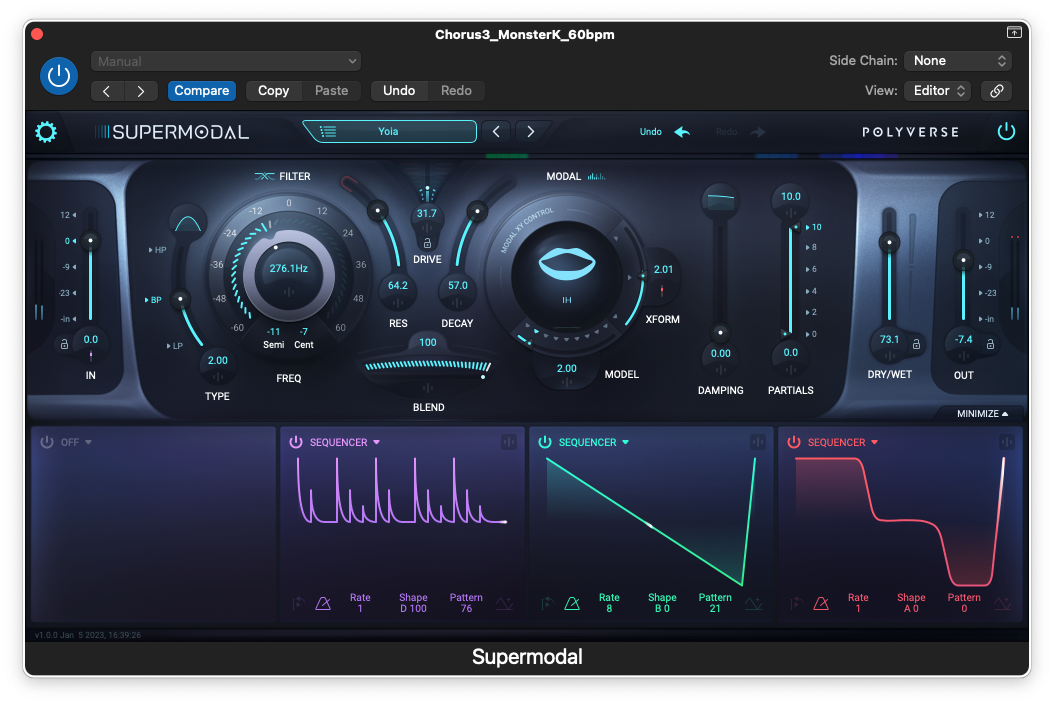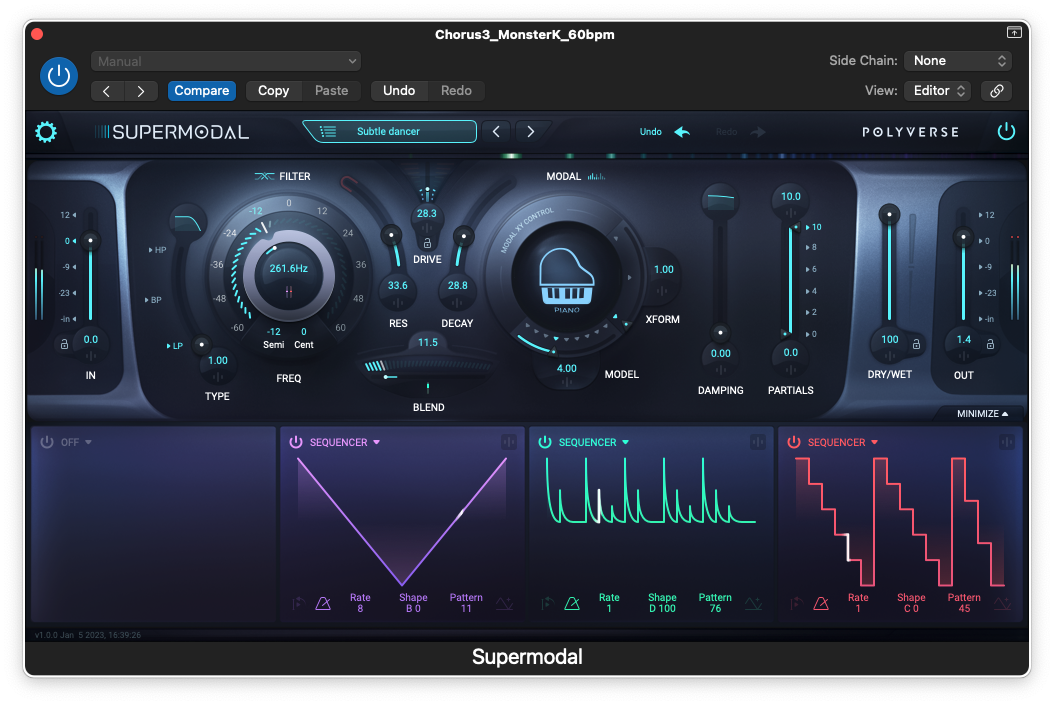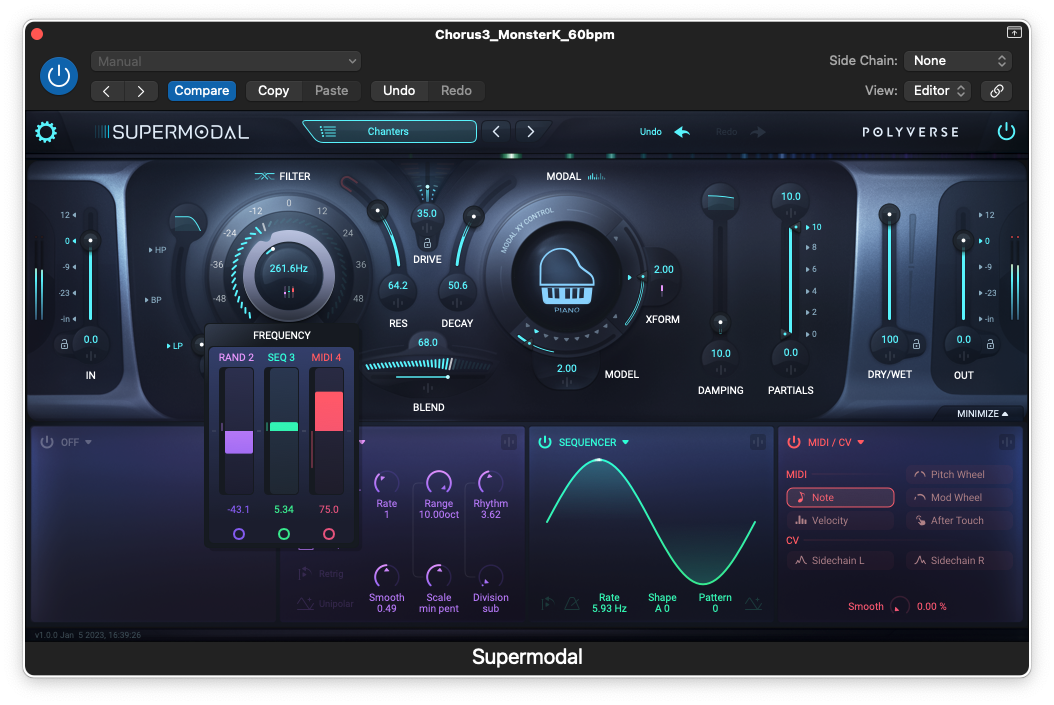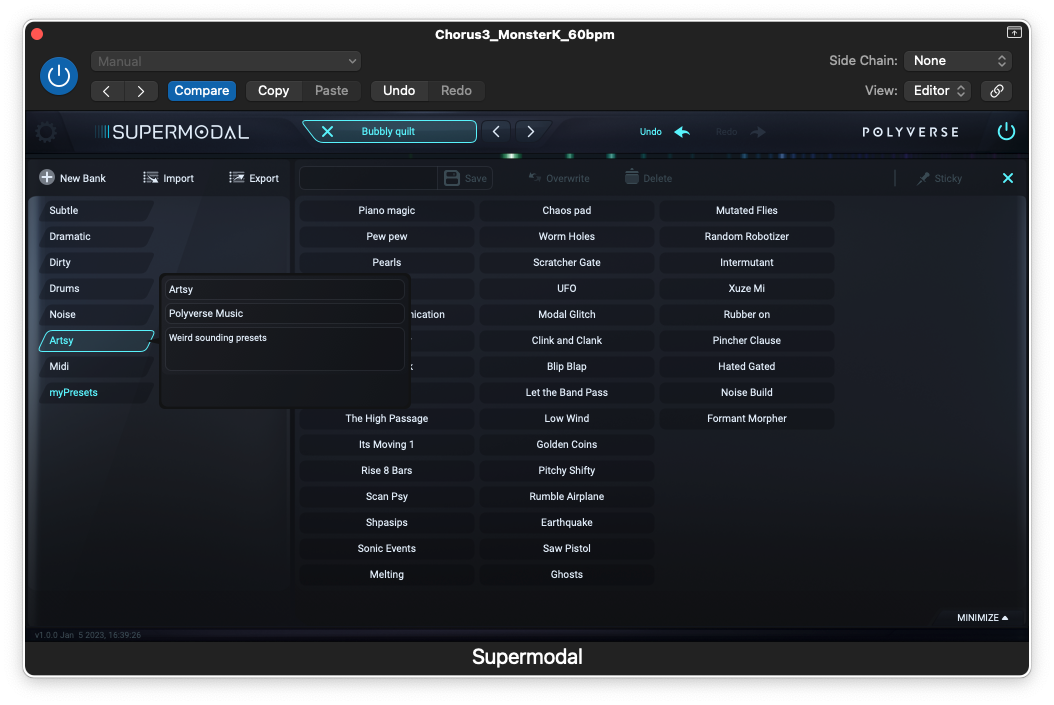Polyverse Supermodal Review
- April 18, 2023
- by Steve Castellano
- Product Intelligence Report

If you’ve read more than a couple of my reviews you might already know that I’m immoderately fond of filters. I might even go so far as to say I like filters better than amplifiers, though it’s a bit like saying you like your kidneys better than your lungs.
In the hardware world, if you have one good filter per voice, you’re doing okay. Two filters and you’re really ahead of the curve. Three filters and you can call it a filterbank. Twenty fixed filters and you’re into graphic EQ or vocoder territory. Two hundred and one filters though? What on earth could you do with that kind of power? Polyverse, creators of the remarkable filter plugin Supermodal, have done some research into the subject and come up with some pretty cool answers.
201 filtrations
When you launch Supermodal, you’ll see two large concentric controls in the upper half of the window. On the left is a stereo 24 db/octave state-variable filter which can be adjusted smoothly from low pass through band pass to high pass, with resonance that can be driven into self-oscillation. You can also add a nice warm saturation with the Drive control. In the centre of this control is the global frequency setting which is displayed in semitones and cents as well as Hz. All these features are fully automatable through up to four modulation sources which we’ll talk about in detail later. So far, so good.
To the right of this filter is the Modal filter control. This is where your remaining 200 filters live (100 bandpass filters per stereo channel), further organized into 27 modes – complex models that emulate real, virtual and imaginary materials and spaces. These are organized into 9 “models” with three variations each, called transformations, which can be selected through the Xform control.

Audio à la mode
I found the idea of a modal filter a bit difficult to grasp at first. A simple way to look at it is a collection of peaks and troughs in an EQ curve that defines the sound of a space – your mouth, when it’s creating vowel sounds, or the body of an acoustic piano. Then extrapolate that to how the world sounds when you press your ear against a plank of wood. And in fact Supermodal has models for vowels, based on samples of real-life vocalizations, struck instruments like pianos, bells and vibraphones, and solid materials like metal, glass and wood.
There are other mathematically derived modes that do not have direct analogues to the physical world. You can think of these more as mathematical distributions of peaks and troughs – random ones like noise, mathematically derived waveforms like saw, square and hypersquare, and chord-based modes resembling strings and pure intervals. And just as you can transition through the state-variable filter states, you can pick a spot in between two or more modes, or even move around between them in real time.
To further sculpt the sound of your modal filter, you have a number of additional controls beyond the modes themselves. Decay appears opposite the state-variable filter’s Resonance control, and determines how long the Modal filter is allowed to ring. Damping allows you to gradually reduce high frequency content, while the dual Partials controls let you limit the available partials, from the top down (similar to a low pass filter) or bottom up (high pass). Blend allows you to specify the balance between the two filter sections, while the global Dry/Wet control does exactly what you would expect.

Bringing modes to life
As novel and engaging as these filters are in combination, filters truly come to life when they are in motion. Supermodal’s Modulation section allows you to keep your filters moving in a variety of ways. This section offers four slots into which you can drop one of six modulator types:
- The Meta Knob allows you to control any parameter or combination of parameters with a single knob.
- The ADSR is a velocity-sensitive, MIDI note-triggered 4-stage envelope with stage times adjustable in milliseconds from 0 to 5 seconds.
- The MIDI/CV allows you to assign MIDI messages and sidechain inputs into modulators.
- The Envelope Follower includes Attack and Release controls and can be applied to incoming signals or sidechain inputs in mono and stereo.
- The Sequencer is a 16-step sequencer which, in combination with its Pattern and Shape controls, can also function as a complex LFO, producing everything from sine waves to chaotic squiggles.
- The Random Generator produces random voltages and rhythms with tempo sync and scale quantization options which can be used to create generative melodies.
The four modulators you choose can be applied to destinations in varying proportions, positive and negative, and can also be used to modulate each other, for modular-style routing flexibility.

Supermodal in the mix
The sonic potential is somewhat difficult to sum up. Once we step out of the realm of our familiar subtractive synthesis model, you really have to play around with it to understand what’s possible. The vowel modes are pretty easy to grasp, if you’re familiar with formant synthesis. But hearing a drum loop transformed into… some kind of piano? That’s something you need to hear for yourself.
At its simplest, Supermodal is great at emulating traditional modulation effects, and there are many options provided in the presets. And due to the way the plugin is structured, you can enjoy rich phasing and flanging effects without the “thinning out” of your source material that you may be accustomed to. But of course it does much more than that. Playing with the Drive option can give you some very satisfying saturation effects. Taking advantage of Supermodal’s MIDI-controlled effect capability allows you to use it as a stereo filter for an existing softsynth. And the deep modulation capabilities, particularly in conjunction with the Decay feature, can weave any source material into a cascade of sweeping, swirling, ringing arpeggios.
Conclusions
It’s probably obvious at this point that I liked playing with Supermodal a lot. In fact, just over the course of demoing the factory presets with some fairly standard drum loops, I found myself pausing now and then to bounce a track down and archive the result for future compositions. But you don’t need to worry too much about finding your way back to your favourite patches – the native patch management is well-thought-out and easy to navigate. All I needed to do on my Mac was right-click a preset name to rename it, and hitting return saved it automatically in the empty “myPresets” folder.

On that note, with everything that’s going on in Supermodal, you’d think it might be complicated to operate. It is, in fact, very approachable and intuitive. Double-click on pretty much any number you see in the UI to enter a value numerically. Modulation patch points are indicated by a miniature vertical fader graphic, representing the four possible modulation sources, and the modulators themselves are colour-coded. The manual is helpful and well-written, but you can skim it for the basics of modes and just jump right in to start making music. And if you’re like me, Supermodal won’t be a plugin that you’ll set aside for when you need it in the future – you’ll want to start creating new sounds with it right away.
Author

Steve Castellano
Steve Castellano is a musician and writer living in Toronto, Canada. He holds a music degree from York University, where his focus was electronic music and composition. He currently records and performs modular electronic music under the name Elettronica Sperimentale.